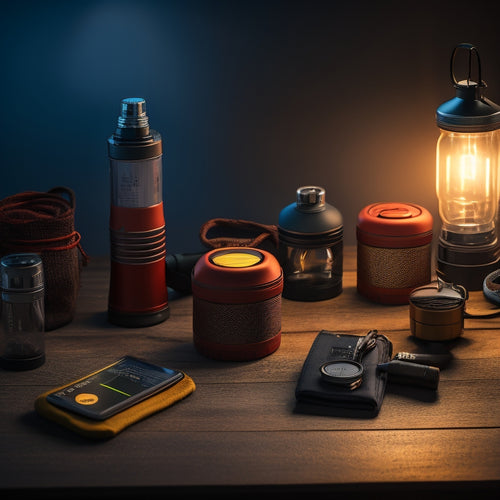
10-Step Guide to Creating a Reliable Battery Bank
Share
To create a reliable battery bank, you'll need to take into account several key factors. First, choose the right battery chemistry for your off-grid system, as it affects charging efficiency and maintenance. Next, make certain your system is scalable to manage loads and inverter compatibility. Regular maintenance, including monitoring state of charge, voltage, and temperature, is also essential. You'll need to prevent deep discharging, implement battery balancing systems, and calculate your energy storage capacity to match your load's energy demands. By following these steps, you'll be well on your way to building a reliable battery bank that provides consistent power - and there's more to investigate to optimize your system's performance.
At a Glance
- Effective battery management and monitoring enhance performance and ROI by preventing battery failure and optimizing charging habits.
- Oversizing the battery bank and proper charging prevent battery failure, and temperature management is crucial for battery health.
- Understanding Depth of Discharge (DOD) is essential for battery lifespan, and maintaining a shallow DOD (20%-50%) prevents deep discharging.
- Battery chemistry influences charging efficiency, maintenance, and environmental impact, making it a key design factor for off-grid systems.
- Regular maintenance, including monitoring state of charge, voltage, and temperature, is essential for safety, performance, and overall reliability.
Reliability in Off-Grid Systems
When you design an off-grid system, you're responsible for ensuring it operates reliably, even when the grid is down.
To achieve this, you'll need to take into account system design factors that prevent battery failure, such as oversizing, proper charging, and temperature management.
Effective battery management and monitoring online monitoring also play an essential role in optimizing performance and ROI.
System Design Considerations
Most off-grid systems require a reliable battery bank to guarantee a steady supply of power. As you design your system, you'll need to evaluate several key factors to ascertain your battery bank meets your energy needs.
| System Design Considerations | Impact on Reliability |
|---|---|
| Battery Chemistry | Affects charging efficiency, maintenance practices, and environmental impact |
| System Scalability | Impacts load management, inverter compatibility, and sizing calculations |
| Maintenance Practices | Influences safety protocols, installation guidelines, and overall system reliability |
| Environmental Impact | Impacts battery longevity, system scalability, and overall system reliability |
You'll need to balance these factors to create a reliable battery bank that provides a steady supply of power. Reflect on the type of battery chemistry that best suits your needs, bearing in mind charging efficiency, maintenance practices, and environmental impact. Ascertain your system is scalable to accommodate changing energy demands, and develop a load management strategy that prevents over-discharge. By carefully evaluating these system design factors, you'll be well on your way to creating a reliable battery bank that meets your off-grid energy needs.
Battery Failure Prevention
You've invested time and resources into designing a reliable off-grid system, and now it's important to confirm your battery bank remains healthy and functional.
Battery failure prevention is fundamental in guaranteeing your system operates smoothly and efficiently. To prevent battery failure, regular battery maintenance is vital. This includes monitoring your battery's state of charge, voltage, and temperature. It's also important to keep your batteries clean and secure, confirming proper ventilation and avoiding extreme temperatures.
Another key aspect of battery failure prevention is managing charging cycles. Deep discharging can greatly reduce your battery's lifespan, so it's crucial to avoid this by confirming you have a suitable charge controller and monitoring your battery's state of charge.
By doing so, you'll be able to limit the number of charging cycles, thereby extending your battery's lifespan. Additionally, consider implementing a battery balancing system to confirm each battery is charged and discharged evenly.
Increased Energy Independence Days
You're likely considering a battery bank to increase your energy independence days, and that means sizing your energy storage capacity correctly. This is critical because it determines how long you can power important systems during grid outages or periods of low renewable energy production.
By optimizing your energy storage capacity, you can guarantee that necessary systems like refrigeration, lighting, and communication stay online when you need them most.
Understanding Depth of Discharge (DOD) is also important, as it affects battery life and efficiency. Higher DOD levels can lead to faster degradation rates, so it's important to strike a balance between energy independence and battery longevity.
Energy Storage Capacity
How much energy can your battery bank store, and what does that mean for your energy independence? Your energy storage capacity is determined by the total ampere-hours (Ah) of your battery bank, which is directly related to the number of days you can go off-grid. A higher energy storage capacity means you'll have more power available during extended grid outages or when the sun isn't shining.
Energy density, measured in watt-hours per kilogram (Wh/kg), is also essential. It affects the physical size and weight of your battery bank, which can impact your system's overall cost and installation complexity. Look for batteries with high energy density to maximize your storage capacity while minimizing space requirements.
The number of charge cycles your battery can handle also plays a significant role. A higher cycle life means your battery bank will last longer and require less maintenance.
When selecting batteries, consider those with a high cycle life to guarantee your energy storage capacity remains reliable over time. By choosing the right batteries, you'll be able to enjoy increased energy independence and a more sustainable lifestyle.
Powering Critical Systems
When designing an off-grid energy system, powering essential systems is fundamental to achieving increased energy independence days. You'll need to prioritize critical loads, such as refrigeration, lighting, and communication systems, to guarantee they remain operational during extended grid outages.
A reliable battery bank is imperative for providing emergency backup power. To achieve this, consider incorporating renewable sources, such as solar or wind power, to charge your battery bank. Portable solutions, like solar generators, can also provide a dependable source of power during emergencies.
Regular maintenance strategies, including monitoring and testing, are essential to guarantee your battery bank remains healthy and efficient. When selecting battery technology, consider the environmental impact and cost analysis of different options.
Look for batteries with a long lifespan and low maintenance requirements to minimize costs and reduce waste. During installation, follow proper installation tips to guarantee your battery bank is configured correctly and safely.
Depth of Discharge Matters
You'll need to understand how to calculate the depth of discharge (DOD) of your battery bank, as it greatly impacts the lifespan of your batteries.
There are different methods to calculate DOD, and choosing the right one is essential for optimizing your system's performance. Maintaining a shallow DOD, ideally between 20% to 50% of capacity, helps prevent frequent deep discharging, which can shorten battery lifespan Capacity Testing and Monitoring.
DOD Calculation Methods
As a vital aspect of battery bank management, calculating the depth of discharge (DOD) is essential to guarantee the longevity and overall health of your batteries. You must understand that DOD importance lies in its impact on your battery's lifespan and performance.
To accurately calculate DOD, you'll need to know the total capacity of your battery bank and the amount of energy used.
There are two primary DOD calculation methods: the ampere-hour method and the state-of-charge method. The ampere-hour method involves tracking the total ampere-hours discharged from your battery bank. This method provides a direct measurement of DOD, but it can be complex and time-consuming.
The state-of-charge method, on the other hand, uses the battery's voltage and temperature to estimate the DOD. This method is simpler and more convenient, but it's less accurate than the ampere-hour method.
Regardless of the method you choose, accurate DOD calculations are essential to guarantee you're not over-discharging your batteries, which can lead to premature aging and reduced performance.
DOD Affects Lifespan
Deep in the heart of battery bank management lies the vital understanding that depth of discharge (DOD) has a significant impact on your battery's lifespan. You need to grasp this concept to optimize your energy storage system. A deeper DOD means more energy is extracted from your batteries, which can lead to a shorter cycle life. Conversely, a shallower DOD can increase energy efficiency, but may not fully employ your battery's capacity.
Discharge rates, battery chemistry, and maintenance practices also influence the relationship between DOD and lifespan. For instance, lithium-ion batteries are more sensitive to DOD than lead-acid batteries.
Your charging strategies, usage patterns, and thermal management techniques also play an essential role in determining your battery's lifespan. Load balancing and environmental impact are additional considerations.
Match Ah to Loads
You'll need to verify your battery bank's total Ah capacity meets your load's energy demands.
To do this, you'll need to calculate your load's capacity needs in watt-hours (Wh) and then match them to the battery's Ah rating.
This is particularly important when considering high-depth-of-discharge (DOD) ratings, which can greatly impact the usable energy of your battery bank.
Load Capacity Needs
Your battery bank's load capacity needs are directly tied to the total ampere-hours (Ah) required to power your appliances and devices. To determine this, you'll need to conduct a thorough load estimation.
This involves calculating the total power consumption of all your devices and appliances, including their individual wattage, voltage, and usage patterns.
You'll need to take into account the average daily usage of each device, as well as any peaks in power consumption. For example, if you have a refrigerator that consumes 100W of power, but only runs for 8 hours a day, you'll need to factor that into your load estimation.
You should also take into account any seasonal variations in usage, such as increased power consumption during summer months when air conditioning is in use.
Battery Ah Ratings
Battery Ah ratings refer to the total capacity of your battery bank, measured in ampere-hours (Ah), which must match the load requirements calculated earlier.
To guarantee you're getting the right batteries, you need to take into account the battery chemistry, as different chemistries have varying capacities. For instance, lead-acid batteries typically have lower Ah ratings than lithium-ion batteries.
When selecting batteries, you should also take into account the number of charging cycles you need. If you plan to cycle your batteries frequently, you'll want batteries with a higher cycle life.
Additionally, you should factor in the depth of discharge (DOD) to guarantee your batteries can handle the load requirements.
Lower Self-Discharge Rate
You're likely aware that batteries naturally lose capacity over time, even when not in use.
A lower self-discharge rate means your batteries will retain their capacity for longer, reducing the need for frequent recharging.
Slow Capacity Loss
When selecting a battery bank, opting for cells with slow capacity loss can greatly extend their lifespan.
You'll want to prioritize cells with low capacity loss rates, as they'll retain their charge over time, ensuring your battery bank remains reliable. This is especially vital for off-grid systems, where you may not have access to frequent charging.
To manage capacity loss, you'll need to implement effective capacity management strategies. This involves regularly monitoring your battery bank's performance, tracking its state of charge, and adjusting your charging and discharging habits accordingly.
Performance monitoring tools can help you identify potential issues before they become major problems.
Frequently Asked Questions
Can I Mix Old and New Batteries in My Battery Bank?
You shouldn't mix old and new batteries, as it'll compromise your overall battery performance and reduce the lifespan of the entire bank, leading to uneven charging and discharging, and ultimately, system instability.
How Often Should I Check and Maintain My Battery Bank?
You're one malfunction away from darkness, but regular checks can avert disaster; establish a maintenance schedule to monitor battery health, ensuring your energy independence isn't compromised - aim to inspect every 3-6 months, and perform deep maintenance every 6-12 months.
What Is the Ideal Operating Temperature for My Battery Bank?
You'll want to maintain your battery bank between 20°C to 25°C (68°F to 77°F) for ideal battery performance, as temperature effects can greatly impact lifespan and capacity; avoid extreme temperatures to guarantee reliable energy storage and freedom from grid dependence.
Can I Use a Battery Bank With Different Battery Chemistries?
You're wondering if mixing battery chemistries is okay; however, it's essential to prioritize battery compatibility, as it greatly affects charging efficiency, and mismatched chemistries can lead to reduced performance, safety issues, and even system failure.
How Do I Safely Dispose of Old or Damaged Batteries?
Can you really just throw away old batteries? Don't risk it! You'll need to safely dispose of them to avoid battery hazards. Take them to a recycling center for proper battery recycling, ensuring a toxic-free environment and freedom from harm.
Explore More
You've finally perfected the art of crafting a reliable battery bank! With these 10 steps, you'll be enjoying a virtually unlimited supply of energy independence days. Remember, a well-designed battery bank is the backbone of any off-grid system, and by following these guidelines, you'll be able to sleep soundly at night, knowing your system will keep humming along like a well-oiled machine. By doing it right, you'll be generating power like a pro, and your energy worries will be a thing of the past!
Related Posts
-

Best Solar Powered Flashlights for Emergency Situations
When you're choosing the best solar-powered flashlights for emergency situations, focus on their brightness, battery ...
-

Solar Powered Lights for Sustainable Home Decor
Solar-powered lights offer a stylish and eco-friendly way to enhance your home decor. They capture sunlight, converti...
-

Essential Hiking Lights for Safety and Fun
When you're hitting the trails, essential hiking lights are vital for safety and fun. A lightweight headlamp offers h...


